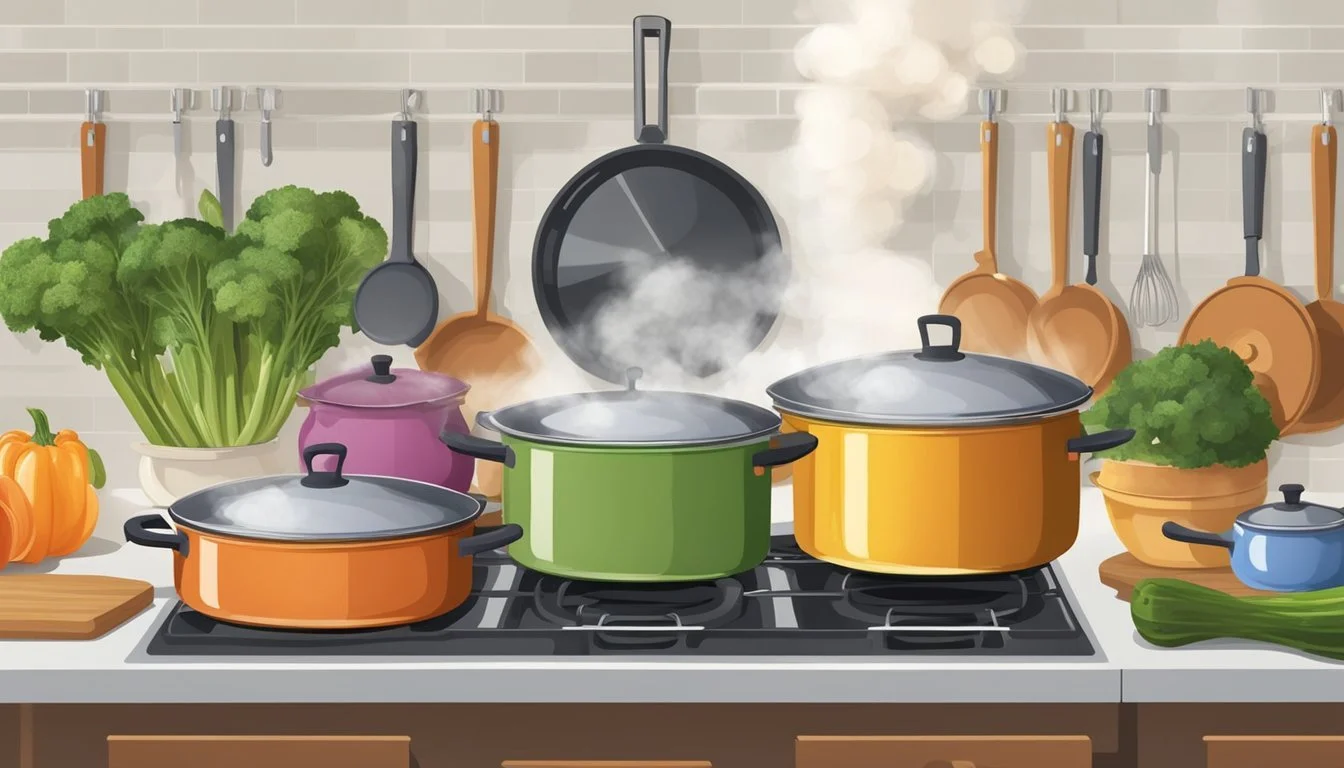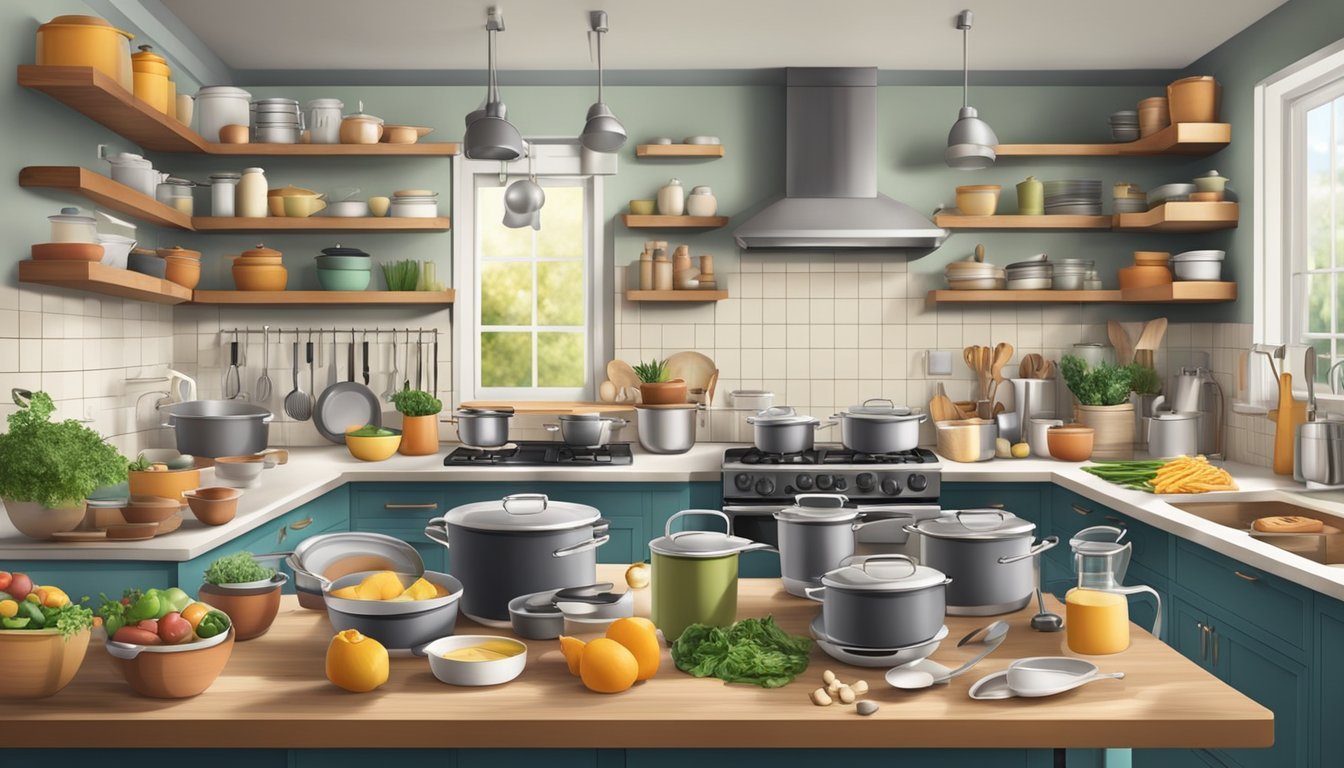How to Cook When You're Feeding a Crowd on Short Notice
Efficient Strategies for Large-Scale Meals
Cooking for a crowd often involves a careful mix of planning and adaptability. When the notice is short, the key to success lies in leveraging both efficient recipes that feed a large number with minimal stress and a strategic approach to meal preparation. Whether it's for a spontaneous family gathering or an impromptu party with friends, the ability to whip up a satisfying meal for a large group doesn't have to be a daunting task.
They must first consider the available ingredients, cooking equipment, and the dietary preferences of their guests. By focusing on dishes that are known for being crowd-pleasers, where simplicity and taste overlap, they can diminish the stress usually associated with cooking large quantities of food. Dishes that can be prepared ahead of time or cooked in a single pot or pan can save time and energy while still providing a hearty and enjoyable meal for everyone.
A host can keep their guests satisfied by choosing versatile recipes such as casseroles, stews, or pasta dishes that can be easily scaled up. It’s also prudent to include at least one or two dishes that require minimal preparation, like a salad or cold appetizers, to serve alongside more time-intensive entrees. This strategy allows them to accommodate a crowd without compromising on the quality or variety of the meal being served.
Understanding Your Crowd
When cooking for a crowd on short notice, the chef needs to have a clear understanding of two key aspects: the size of the crowd and the varied dietary preferences present within the group. This ensures that the food prepared is sufficient and appropriate for everyone attending.
Determining Crowd Size
The first step is to ascertain the number of guests. A precise headcount gives the chef the necessary information to quantify ingredients and portion sizes. For large groups, it’s essential to prepare in bulk, opting for dishes that are scalable and easily served.
Considering Dietary Preferences
The chef must acknowledge the diverse dietary preferences and restrictions of the crowd. This includes recognizing the needs of:
Vegetarians: Ensure there's a variety of plant-based options.
Meat-Lovers: Provide substantial dishes featuring beef, pork, or poultry.
By carefully balancing the menu to cater to different dietary preferences, the chef can both respect individual needs and create a harmonious dining experience for the entire group.
Menu Planning
When feeding a crowd on short notice, one must select dishes that are versatile, plan a balanced menu, and include make-ahead options to ensure a seamless dining experience for guests.
Selecting Versatile Dishes
Choosing recipes that can be easily adjusted for the number of guests is crucial. It's efficient to focus on dishes that can be expanded without compromising flavor or quality. For example, Church Supper Spaghetti is a dish that can be easily scaled up and is popular with many palates, making it a versatile choice for an entree. Additionally, French Dip sandwiches can be prepared in bulk and allow guests to serve themselves.
Planning a Balanced Menu
A balanced menu should include a variety of appetizers, entrees, sides, and desserts to cater to different tastes and dietary preferences. One should consider dishes that cover the main food categories such as:
Protein: Offer varieties like pork or chicken, such as the ever-popular Chicken Cordon Bleu (What wine goes well with chicken cordon bleu?) for a touch of elegance.
Vegetarian Options: Include at least one plant-based dish to accommodate non-meat eaters.
Sides: Choose sides that complement the main dishes, like roasted vegetables or a hearty salad.
Dessert: End the meal with a simple yet satisfying dessert, such as a fruit cobbler that can be made in large batches.
Including Make-Ahead Options
Incorporate recipes into the menu that can be made ahead of time to reduce last-minute preparation. Dishes like cold appetizers, salads, or slow-cooker recipes can be prepared in advance and served when needed. This strategy not only streamlines service but also allows one to manage their time more effectively on the day of the event.
Preparation Strategies
When cooking for a crowd on short notice, the key to success lies in efficient shopping, strategic cooking in batches, and serving dishes that are palatable at room temperature to ease service and timing.
Efficient Shopping Techniques
One should create a comprehensive shopping list that groups ingredients by sections of the store, such as produce, meats, and dairy, for a quicker shopping experience. One might consider ready-to-use ingredients, like pre-cut vegetables or grated cheese, to save time. Bulk buying is also efficient for main ingredients, ensuring there's enough to serve everybody.
Cooking in Batches
Cooking in batches is essential for serving hot food without delay. Utilize the oven strategically, baking side dishes while mains are cooking on the stove. Planning dishes that use similar cooking temperatures can maximize oven space and reduce the need for adjustments. A buffet setup could be ideal, as it allows for dishes to be served and replenished smoothly.
Room Temperature Dishes
Incorporating room temperature dishes alleviates the pressure of keeping all food hot and allows for advance preparation. Salads, pasta, and antipasto platters maintain their flavor and quality at room temperature, making them perfect as sides. They also offer a refreshing balance to hot mains, enriching the dining experience.
Serving a Large Group
When preparing meals for a large group, it’s essential to calculate accurate food portions, set up an efficient buffet system, and keep food at safe temperatures to ensure a successful and enjoyable event.
Calculating Portions
Accurately determining how much to cook is foundational in hosting a large gathering. As a rule of thumb, one should consider the type of event, the mix of adults and children, and the length of the event. A practical approach to calculating portions for each guest could involve:
Proteins: 5-7 ounces per person
Sides: 4-6 ounces per side dish, per person
Desserts: One to two servings per person
Setting Up a Buffet
Efficient buffet setups allow guests to move smoothly and serve themselves. They should have a logical flow, with plates at the start and flatware and napkins at the end to prevent any bottleneck. Arrange dishes in the following manner:
Starters: Salads, soups or appetizers
Main Courses: Placed on larger platters for easy access
Sides: Sequenced next to main dishes
Desserts: Positioned at a separate table if space allows
Keeping Food at Safe Temperatures
Maintaining the right temperature for dishes is critical for food safety and quality. They should follow these guidelines:
Hot dishes: Should be maintained at 140°F or above. Use chafing dishes or warming trays.
Cold dishes: Keep at 40°F or below. Nestle dishes in bowls of ice when possible.
By attention to these aspects, one ensures both the satisfaction and safety of their guests, reinforcing their reputation as an excellent host.
Quick and Easy Recipes
When feeding a crowd on short notice, one needs recipes that are simple to execute yet deliver on flavor. The dishes outlined below ensure a satisfying meal with minimal fuss, covering all parts of the meal from appetizers to desserts.
Tasty Appetizers
Appetizers set the stage for the meal. They should be flavorful and easy to share. Consider these options:
Fruit and Cheese Platter: A selection of cheeses, fresh fruits, and crackers can be assembled quickly.
Caprese Skewers: Thread cherry tomatoes, mozzarella balls, and fresh basil on skewers and drizzle with balsamic glaze.
Hearty Main Courses
Main courses should be filling and able to cater to a variety of tastes. Here are a couple to include on your menu:
Lasagna: Layered with noodles, cheese, meat or vegetables, and sauce, lasagna can feed many and even be prepared ahead of time.
Chicken Pot Pie (What wine goes well with chicken pot pie?): A comforting choice with tender chicken, vegetables, and a golden crust, it can be made in a large dish and served easily.
Satisfying Sides
Side dishes complement the main courses by adding diversity and balance to the meal. Quick options include:
Baked Ziti: A pasta dish that's similar to lasagna but less time-consuming. Mix cooked ziti with sauce and cheese, then bake until bubbly.
Garlic Bread: A crowd-pleaser side that pairs well with pasta dishes. Spread butter, garlic, and herbs on bread and broil until golden.
Delicious Desserts
End the meal on a high note with sweet treats that require minimal effort.
Sheet Cakes: Bake your favorite cake batter in a sheet pan for a simple dessert that serves many.
Ice Cream Sundae Bar: Set out various ice cream flavors and toppings like sprinkles, sauces, and fruit for guests to make their own sundaes.
Beverage Considerations
When planning beverages for a large crowd, organizers must ensure a balance of options and ease of preparation. It's essential to include both alcoholic and non-alcoholic choices and to prepare for large batches when it comes to frequently consumed hot drinks like tea and coffee.
Alcoholic and Non-Alcoholic Variations
For a successful event, one must provide a diverse selection of beverages to cater to all guests. Punch serves as an excellent option for both alcoholic and non-alcoholic variations, allowing for easy customization and volume. When preparing alcoholic punch, a common ratio is one part alcohol to three parts other ingredients, ensuring a balanced flavor that isn't too potent. Here's a simple alcoholic punch formula:
1 part alcohol: such as rum or vodka
2 parts fruit juice: choose flavors that complement the alcohol
1 part soda: for a bubbly effect
Likewise, non-alcoholic punch can follow a similar structure but replace alcohol with a mix of fruit juices or a non-alcoholic sparkling option.
3 parts fruit juice
1 part soda: like sparkling water to add a fizzy touch
Always provide ample water, as hydration is crucial. A self-serve carafe or dispenser can make it accessible and easy for guests.
Brewing Large Batches of Tea and Coffee
For gatherings, especially in the morning or afternoon, tea and coffee are staples. To serve large groups, one must consider efficient brewing methods to keep the beverages flowing.
For tea, consider using:
Large infuser baskets for loose-leaf tea
Multiple teabags in a large dispenser
For every 8 ounce serving, one will need about 1 teaspoon of loose-leaf tea or one teabag. It's also helpful to have a variety of tea types, such as black, green, and herbal, to suit different preferences.
Coffee can be prepared in large urns or coffee makers designed for events. A standard measure for a crowd is:
1 to 2 tablespoons of ground coffee per 8 ounce cup
Water: hot and preferably filtered for the best taste
Having decaf options alongside regular coffee caters to all guest needs. Set up self-serve stations with cream, sugar, and stirrers to streamline the service.
Stress-Free Hosting
When hosting a crowd on short notice, it's vital to focus on organizing and simplifying the process. This approach helps reduce stress and ensures guests enjoy a memorable experience.
Delegating Tasks
A host can significantly reduce the pressure by assigning specific tasks to friends or family ahead of time. Organizing an event is teamwork, and guests often enjoy contributing to the success of the gathering. Effective delegation might look like this:
Food Preparation: Assign a few guests to bring side dishes or desserts.
Setup: Have a helper arrange seating and decor.
Cleanup Crew: Recruit willing attendees to assist with post-event tidying.
Creating a Relaxing Atmosphere
The atmosphere of an event plays a crucial role in the comfort and enjoyment of guests. Here are specific tactics:
Music: A well-curated playlist can set the mood without overpowering conversation.
Lighting: Soft lighting options, such as candles or dimmable fixtures, can add warmth.
Seating: Adequate and comfortable seating options invite guests to relax and stay longer.
Accommodating Special Diets
When feeding a crowd on short notice, it's essential to consider the diverse dietary needs of your guests. Including vegetarian, vegan, gluten-free, and allergy-friendly dishes ensures that everyone has something to enjoy.
Vegetarian and Vegan Offerings
For vegetarians, chefs recommend preparing high-protein dishes such as pan-seared tofu or sautéed eggplant that can substitute for meat-based proteins. Vegan guests will appreciate dishes that exclude all animal products, like teriyaki tofu or tempeh steaks.
Protein Options:
Teriyaki Tofu
Garlicky Broiled Shrimp (for pescatarians)
Pan-Seared Chicken Breasts (for non-vegetarians)
Vegetable Dishes:
Skillet-Roasted Carrots and Parsnips
Broccoli with Garlic and Lemon
Kale with Red Pepper Flakes
Gluten-Free and Allergy-Friendly Options
For gluten-free guests, preparing dishes without wheat or other gluten-containing grains is crucial. Quinoa salads and roasted sweet potatoes are both safe and satisfying choices. For those with allergies, always inquire about specific needs and avoid cross-contamination during food preparation.
Gluten-Free Dishes:
Roasted Sweet Potatoes
Allergy Considerations:
Use separate utensils and cookware for allergy-friendly cooking.
Label dishes clearly to indicate any potential allergens they may contain.
Transitioning Between Courses
Efficiently managing the transition between courses is crucial when feeding a crowd, particularly when time is limited. Attention must be paid to the efficiency of clearing and cleaning as well as the precise timing of serving each course.
Clearing and Cleaning
One starts by swiftly clearing away dishes from the previous course. Staff or helpers should be assigned to specific tasks — like collecting plates, cutlery, and glasses — to avoid congestion. Using trays makes the process faster and more organized. Once the appetizers have been enjoyed, ensure the space is quickly prepped for the entree by wiping down tables and providing clean cutlery if necessary. This practice not only maintains hygiene but also helps guests transition smoothly to the next course.
During dessert, one might opt for disposable, biodegradable plates or utensils to expedite the final cleanup phase. This is particularly useful if an event extends beyond planned hours, as it allows for a quick and hassle-free conclusion.
Timing Your Serving
The serving of each course should be timed such that guests have adequate time to enjoy their meals without long waits. For large groups, it's effective to serve dishes that are easily scalable and can be prepared in bulk to ensure a continuous flow. For instance:
Appetizers: Choose items that don’t require immediate serving, such as cheese platters or dips.
Entree: Pre-plated meals or buffet stations should be ready as soon as the appetizer course is cleared.
Dessert: Have desserts pre-portioned and easy to distribute, such as cake slices or individual pastries.
By having the next course ready to serve, one mitigates the risk of guests feeling rushed or kept waiting. Coordination between the kitchen and service staff is imperative to this end.
Post-Event Considerations
After the guests have enjoyed the meal and the event winds down, effective management of leftovers and cleaning up efficiently ensures the success of any large-scale meal preparation is sustained beyond the event itself.
Handling Leftovers
Storage: Proper storage is essential to maintain the safety and quality of leftovers. For perishable items, such as meats and dairy products, they should be refrigerated within two hours. It's advisable to divide large quantities into shallow containers to speed up the cooling process. Labelling each container with the content and date ensures easier management and reduces waste. A simple table can assist with keeping track of leftovers:
Food Item Stored On Consume By Roast Beef 03/08/2024 06/08/2024 Vegetable Lasagna 03/08/2024 05/08/2024
Donation: One can consider donating unopened and unused non-perishable items to local food banks or community centers. This not only reduces waste but also supports those in need.
Simplifying Cleanup
Team Effort: Engage a few volunteers or staff to assist with cleanup tasks, dividing the labor into manageable sections such as dishwashing, surface cleaning, and trash disposal. This streamlines the process and reduces the burden on any one individual.
Supplies: Ensure a sufficient stock of cleaning supplies is on hand before the event. This includes dish soap, sponges, trash bags, and sanitizing agents. For those using a buffet setup, having these supplies close to the serving area can facilitate faster cleanup of spills and general tidiness throughout the event.
Catering Equipment: Larger items used in catering, such as chafing dishes and serving utensils, require thorough cleaning and proper storage. Adhering to the manufacturer's instructions for cleaning can prolong the life of the equipment.
By handling leftovers safely and streamlining the cleanup process, one can close the event effectively and without unnecessary stress. This ensures that the event is memorable for all the right reasons, including the manner in which it was concluded.








